Did you know that your ADHD brain might be the perfect companion for uncovering the secrets of ancient civilizations?
Well, welcome to your comprehensive ADHD travel guide to Rome and Athens, where neurodivergent minds transform ancient cities into personal discovery playgrounds!
Picture this: You’re standing atop the Acropolis as the warm Mediterranean breeze carries whispers of ancient philosophies. Your hyperfocus kicks in, and suddenly every weathered column of the Parthenon tells its own story. Time dissolves, and history comes alive through your unique neurodivergent lens.

Welcome, fellow Neurodivergent Navigators! I’m Chadwick, a Licensed Professional Counselor from colorful Colorado who discovered my own ADHD (and later AuDHD) diagnosis just in time to transform my travels.
Through years of exploring ancient wonders and soul-searching, I’ve learned that our unique way of experiencing the world isn’t just “different” – it’s extraordinary.
Whether you’re drawn to unraveling the philosophical depths of Athens or the engineering mysteries of Rome, your neurodiversity is about to become your greatest asset for creating adventures that most travelers only dream about.
Ready to discover how? Let’s dive in!
Harnessing Hyperfocus: Your Secret Weapon for Ancient Exploration
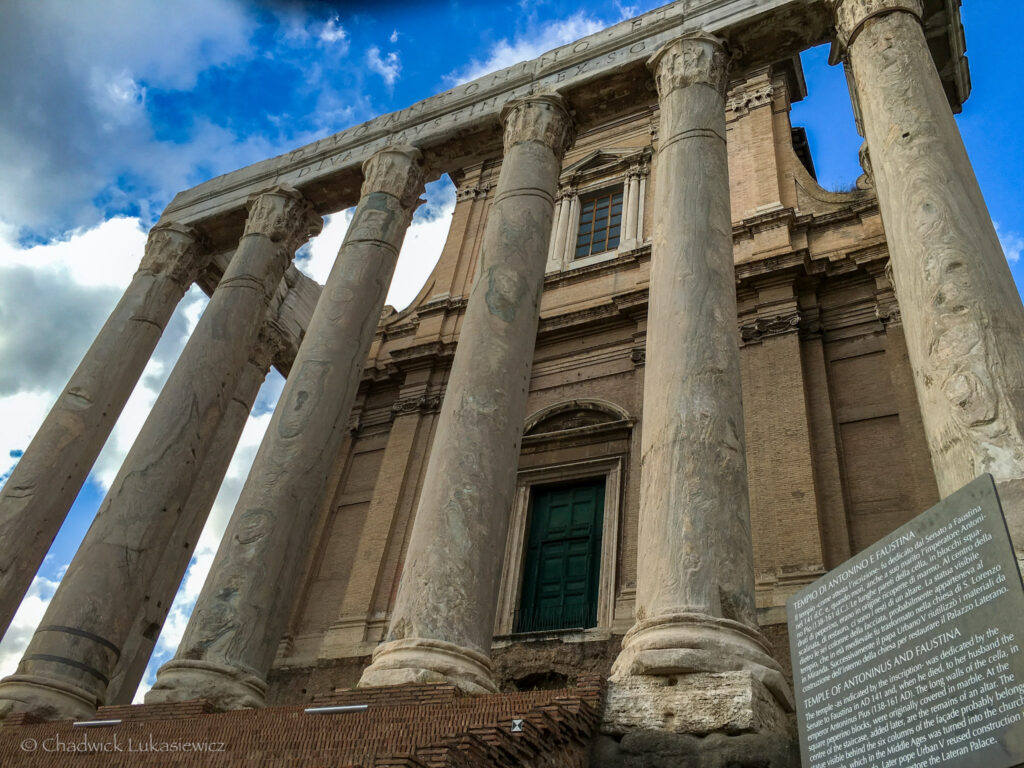
Let’s start with our superpower: hyperfocus. You know that state where time seems to dissolve, and you’re completely absorbed in something fascinating?
That’s exactly what makes exploring ancient historical sites so incredible for our ADHD brains.
Understanding the ADHD-History Connection
Those of us with ADHD often excel at processing rich, detailed information when it aligns with our interests. Combine this with our natural curiosity and pattern-recognition abilities, and suddenly those ancient ruins become a playground for the mind. (Barkley, 2020)
During my time exploring the Roman Forum, my distracted brain (probably looking for shiny objects) led to an unexpected discovery.
While others rushed past what seemed like just another weathered wall, my tendency to notice minute details revealed ancient graffiti – actual messages carved by Roman citizens thousands of years ago!
This is where our ADHD brain’s love for detail becomes a time machine.

Tips for Triggering and Maintaining Beneficial Hyperfocus
Pre-Visit Research Sprints
- Choose one specific aspect of the site that fascinates you
- Allow yourself to dive deep into that topic for 30-60 minutes
- Create a simple bullet-point list of details to look for on-site
On-Site Focus Enhancement
- Bring a small sketchbook for quick architectural drawings
- Take detailed photos of elements that capture your attention
- Use noise-canceling headphones to minimize distracting sounds
Movement Integration
- Walk while you observe – movement helps our ADHD minds focus
- Choose viewing positions that allow gentle rocking or swaying
- Take “climbing breaks” on permitted ancient steps

Making the Most of Your Hyperfocus Moments
Remember, hyperfocus isn’t just “losing track of time” – it’s about creating deeper connections with history.
Here’s some tips to make the most of these powerful moments:
- Set gentle alarms to remind you to drink water and check in with travel companions or self
- Keep a small notepad or journal for recording sudden insights or questions
- Take photos of informational plaques to read later when focus naturally wanes
Navigating Sensory Overload in Bustling Ancient Cities

Let’s face it – as much as we love diving deep into historical details, the sensory experience of exploring ancient cities can be overwhelming.
Between the crowds at the Colosseum and the cacophony of modern Athens, our neurodivergent brains need strategies to manage the stimulation.
Creating Your Sensory Haven in Ancient Spaces
I’ll never forget my first visit to the Pantheon in Rome. The moment I stepped inside, the sheer sensory input nearly overwhelmed me – the echoing voices, the crush of crowds, the play of light through that magnificent oculus.
But thanks to my trusty “sensory survival kit,” I was able to transform potential overwhelm into one of the most profound experiences of my life.
Here’s what I’ve learned about managing sensory input while exploring ancient sites:
The Essential Sensory Emergency Kit

- Noise-cancelling earbuds (I swear by AirPods Pro)
- Sunglasses with polarized lenses (clip-ons work great if you’re blind like me)
- A lightweight, breathable Buff or merino wool scarf that can double as a head covering/sleep mask
- Small vial of familiar, grounding scent or essential oil
- Cooling towel for hot Mediterranean days
- Mobile tripod for photography or watching videos
Identifying and Avoiding Peak Overwhelm Times
- Visit major sites during off-peak hours (early morning or late afternoon)
- Ask locals for recommendations and timings
- Research local festivals or events that might increase crowds
- Plan indoor site visits during the hottest part of the day
Finding Quiet Spaces in Ancient Places

Every ancient site has its hidden havens – you just need to know where to look. As someone who’s both sought and found peaceful spots, let me share my carefully curated list of sensory-friendly sanctuaries.
Peaceful Havens in Athens

National Garden Retreats
- Best Time: Early morning or late afternoon
- Sensory Benefits: Dense tree cover muffles city noise
- Pro Tip: Find the hidden duck pond for natural white noise
- Nearby: Just steps from Syntagma Square if you need a quick escape
Philopappos Hill Sanctuary
- Best Time: Sunset hours
- Sensory Benefits: Elevated position reduces city noise
- Pro Tip: The marble seating area facing the Acropolis offers perfect meditation spots
- Hidden Gem: Small cave-like areas provide natural cooling
First Cemetery of Athens
- Best Time: Mid-morning
- Sensory Benefits: Naturally quiet environment with tree shade
- Pro Tip: The marble paths are perfect for mindful walking
- Note: Remember this is an active cemetery; respect and quiet are essential
Roman Respites

Appian Way Escapes
- Best Time: Weekday mornings
- Sensory Benefits: Open spaces with natural sounds
- Pro Tip: Rent a bike for quick access to quieter sections
- Hidden Spot: Look for ancient tomb ruins with built-in seating
Orange Garden on Aventine Hill
- Best Time: Just after opening or before closing
- Sensory Benefits: Elevated position reduces street noise
- Pro Tip: Find the famous keyhole view of St. Peter’s dome
- Bonus: Adjacent rose garden offers additional quiet spaces
Cloister of San Giovanni in Laterano
- Best Time: Mid-afternoon
- Sensory Benefits: Cool marble surfaces and fountain sounds
- Pro Tip: Less crowded than Vatican sites
- Special Note: Perfect for texture-seeking moments with ancient columns
These spaces offer more than just quiet – they provide complete sensory reset opportunities when the intensity of ancient exploration becomes overwhelming. Remember, sometimes the best way to appreciate history is to step back and process it in peace.
ADHD-Friendly Itinerary Planning for Athens and Rome

Now, let’s tackle one of our biggest challenges – planning! How do we create an itinerary that’s structured enough to keep us on track but flexible enough to accommodate our ADHD brain’s need for novelty?
The “Anchor Point” Method
Instead of planning every minute (which we know our ADHD brains will rebel against), I use what I call the “Anchor Point” method:
- Morning Anchor (9-11 AM)
- One major site or museum
- Clear entrance plan and ticket pre-booking
- Nearby coffee shop identified for pre-visit fuel
- Afternoon Flex Time (12-4 PM)
- List of 2-3 nearby options
- Permission to follow interesting discoveries
- Built-in time for unexpected hyperfocus moments
- Evening Anchor (5-7 PM)
- Scheduled return to accommodation for rest
- Dinner plans (flexible on location)
- Optional evening activity
Sample 3-Day Rome Itinerary Using the Anchor Method

Day 1:
- Morning Anchor: Colosseum (pre-booked early entrance)
- Flex Options:
- Roman Forum exploration
- Palatine Hill wandering
- Local market visit
- Evening Anchor: Trastevere neighborhood for dinner
Day 2:
- Morning Anchor: Vatican Museums (pre-booked skip-the-line)
- Flex Options:
- St. Peter’s Basilica
- Castel Sant’Angelo
- Piazza Navona
- Evening Anchor: Food tour in Centro Storico
Day 3:
- Morning Anchor: Pantheon
- Flex Options:
- Various piazzas
- Trevi Fountain
- Shopping on Via del Corso
- Evening Anchor: Sunset at Pincio Terrace
Movement Breaks and Sensory Integration
Remember, our ADHD brains often focus better with movement. I’ve found these strategies helpful:
- Take stairs instead of elevators when available
- Walk the perimeter of sites before diving into details
- Use hand gestures while listening to guides (discreetly!)
- Incorporate physical grounding exercises between sites
- Bodyweight or band workouts in the morning or evening
Maximizing Learning and Retention: ADHD-Friendly Tour Strategies
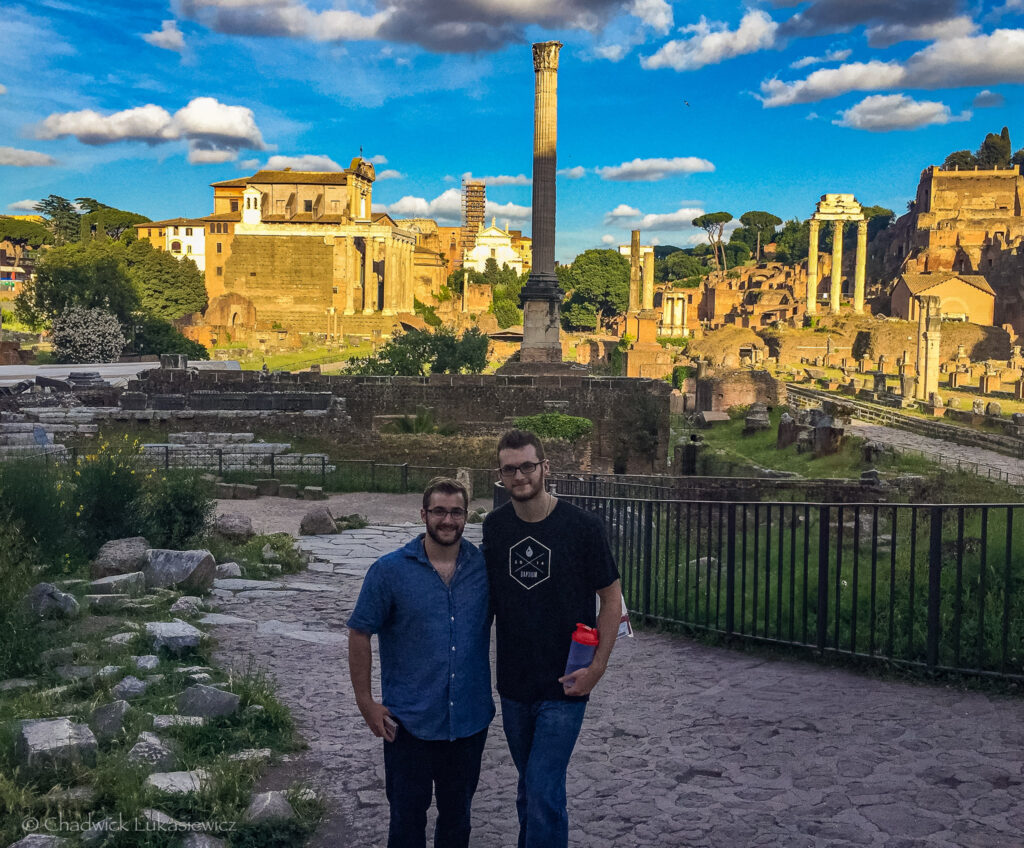
Have you ever found yourself zoning out during a traditional guided tour, only to hyperfocus on a random detail the guide barely mentioned?
You’re not alone!
As an AuDHDer, I’ve learned that our brains often need a different approach to absorb and retain historical information.
Choosing the Right Tour Format
During my visit to the Acropolis, we initially joined a standard group tour but quickly realized I was more focused on the stray cats lounging on ancient marble than the guide’s detailed chronology.
That’s when I learned the importance of choosing tours that align with our neurodivergent learning style.

Best Tour Options for Neurodiverse Travelers:
Small Group Archaeological Tours
- Maximum 6-8 people
- Hands-on experiences when possible
- Freedom to ask detailed questions
- Movement-based learning opportunities
Private Guide Experiences
- Customizable pace
- Flexibility to follow interest-driven tangents
- Ability to take sensory breaks as needed
- Option to focus deeply on specific aspects
Self-Guided Audio Tours
- Control over timing and pacing
- Pause and replay options
- Freedom to move while listening
- No social pressure
Engaging Multiple Senses for Better Memory Formation
Did you know that our ADHD brains retain information better when multiple senses are engaged? (Schulze et al., 2020). Well, here’s how to create a multi-sensory learning experience:

Visual:
- Sketch quick details that catch your eye
- Take photos from unusual angles
- Create visual connections between different sites
Tactile:
- Touch permitted surfaces (always check rules first!)
- Carry a piece of marble or stone similar to ancient materials
- Use fidget toys that match historical textures
Auditory:
- Record your own observations as voice notes
- Listen to period-appropriate music between sites
- Practice pronouncing ancient names and terms
Tech Tools for Enhanced Understanding
Let’s face it – we live in an age where technology can transform our ADHD traits into superpowers for exploring ancient worlds. Here are my tried-and-tested apps that have revolutionized how I experience historical sites:
Organization & Navigation
- Google Maps – Save custom locations and create themed lists
- Rome2Rio – Compare transportation options between sites and cities
- Notion – Build your personal history database with an all-in-one workspace
- Apple Journal / Daylio – Quick capture thoughts and photos
- Pro Tip: Share custom maps with travel companions


Translation & Communication
- Apple Translate – Offline translation with camera features
- Google Lens – Instant sign and menu translation
- Duolingo – Learn essential phrases through gamified lessons
- Pro Tip: Screenshot important translations for quick access


Sensory Management
- Headspace – Guided meditations for overwhelm
- Apple Music/Spotify – Create calming playlists for different moods
- TimeBloc – Visual schedule management
- Pro Tip: Download playlists and meditation tracks for offline use

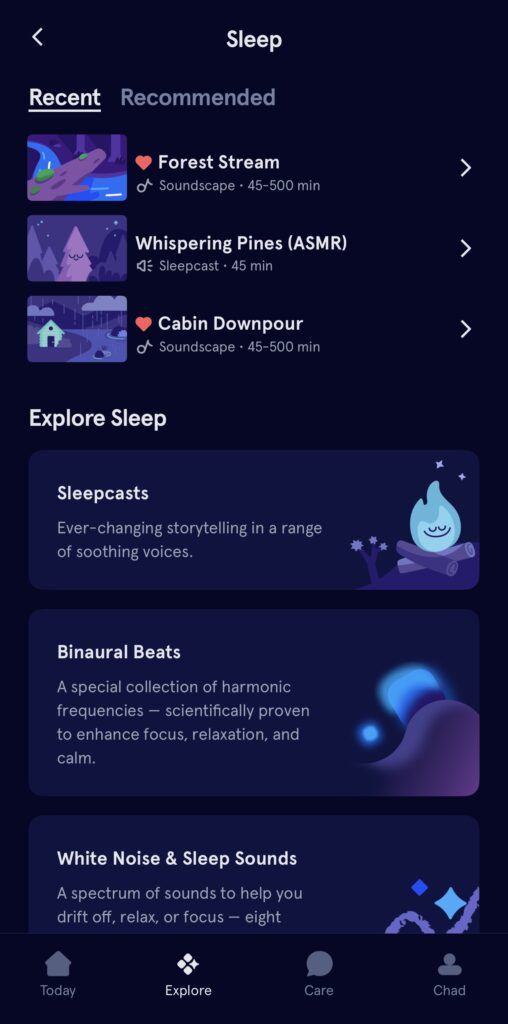
Reality-Enhancing Apps
- Roman Empire AR (iOS/Android) – Visualize ancient ruins as they once stood
- Athens 3D – Interactive reconstructions of ancient landmarks
- Acropolis Virtual Tour – Guided exploration with historical context
- Pro Tip: Download content before your visit for smoother experiences
Essential Reminder: Download everything for offline use! Historical sites prioritized architectural brilliance over WiFi coverage. Also, consider using ExpressVPN to access your favorite streaming services during downtime and protect your data.
Bonus Tip: Keep your phone charged with a portable battery pack – those hyperfocus-inspired photo sessions can drain your battery quickly!
Creating Memory Anchors

Here’s a technique I developed applying my trauma therapy background and travel experiences to ADHD-friendly learning strategies.
I call it the “Sensory Story Method”:
- Choose a specific location within the site
- Identify 3 distinct sensory experiences:
- What you see (architectural details, colors, textures)
- What you feel (temperature, breeze, stone texture)
- What you hear (echoes, footsteps, distant city sounds)
- Create a brief story connecting these elements
- Link the story to one key historical fact
For example, at the Church of the Holy Apostles in Athens, I created this memory: “Standing before the Byzantine sanctuary (visual), watching the morning sun warm the weathered stone and pink oleander blooms (tactile), listening to distant church bells mixing with birdsong (auditory), I imagined centuries of morning prayers echoing through these same arches. This peaceful moment connected me to the city’s transition from ancient Greek to Byzantine traditions.
This personal connection helps cement historical information in our hyperactive ADHD minds.
Capturing Moments: Photography and Journaling for the ADHD Traveler

Let me tell you about the time my neurodivergent time-blindness and love for photography collided at the Temple of Zeus in Athens during sunrise.
While most tourists were still enjoying their morning cappuccinos, I was sitting on an ancient stone, camera in hand, watching the early light over the ruins. That two-hour photo session felt like minutes…well…not to my Mom and brother waiting at the cafe…oops.
Leveraging Hyperfocus for Travel Photography

Our ADHD tendency towards both distraction and hyperfocus can actually can transform us into detail-hunting ninjas with cool cameras.
Here’s how to make the most of these intense creative moments:
Camera Setup for Success
- Keep your camera easily accessible (cross-body strap or tripod works best)
- Pre-set your favorite manual settings
- Have spare batteries or a mobile charger within reach
- Use a light travel tripod for stability during hyperfocus sessions
Photography Themes to Maintain Focus
- Architecture details and patterns
- Light and shadow play
- Ancient textures and materials
- Human interaction with historical spaces
- Scale comparisons (modern vs. ancient)
Pro Tip: I’ve found that setting small photography challenges helps maintain engagement without overwhelming.
For instance, try finding five different architectural details that repeat across various ruins, or challenge yourself to capture the same monument in three dramatically different lighting conditions.
Creative Documentation Techniques
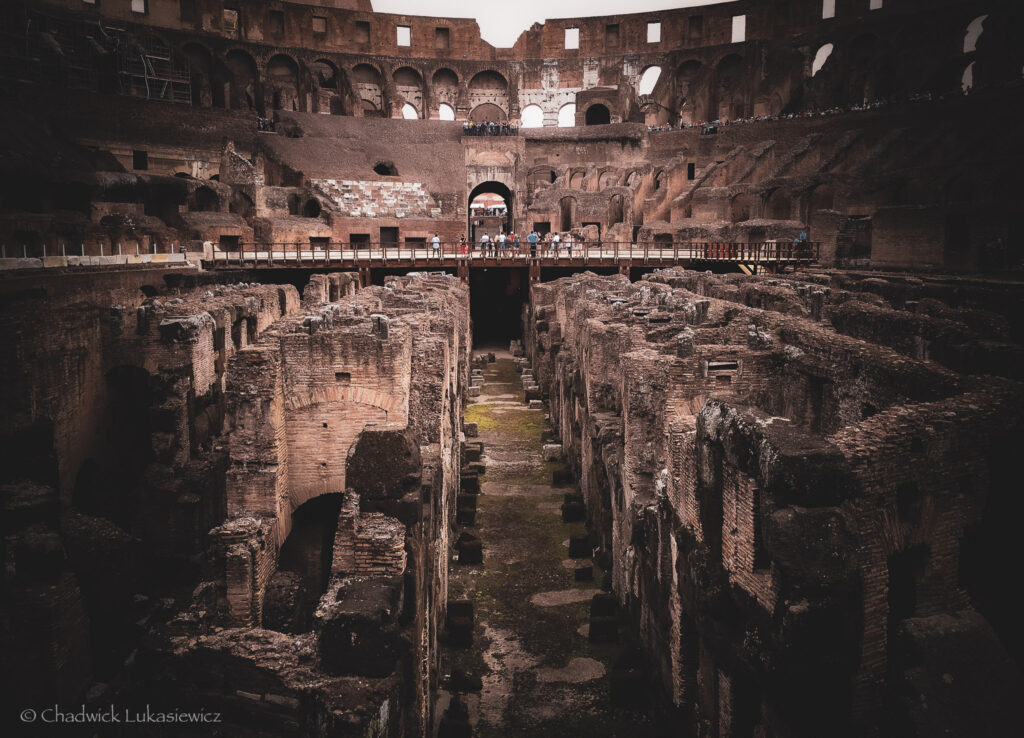





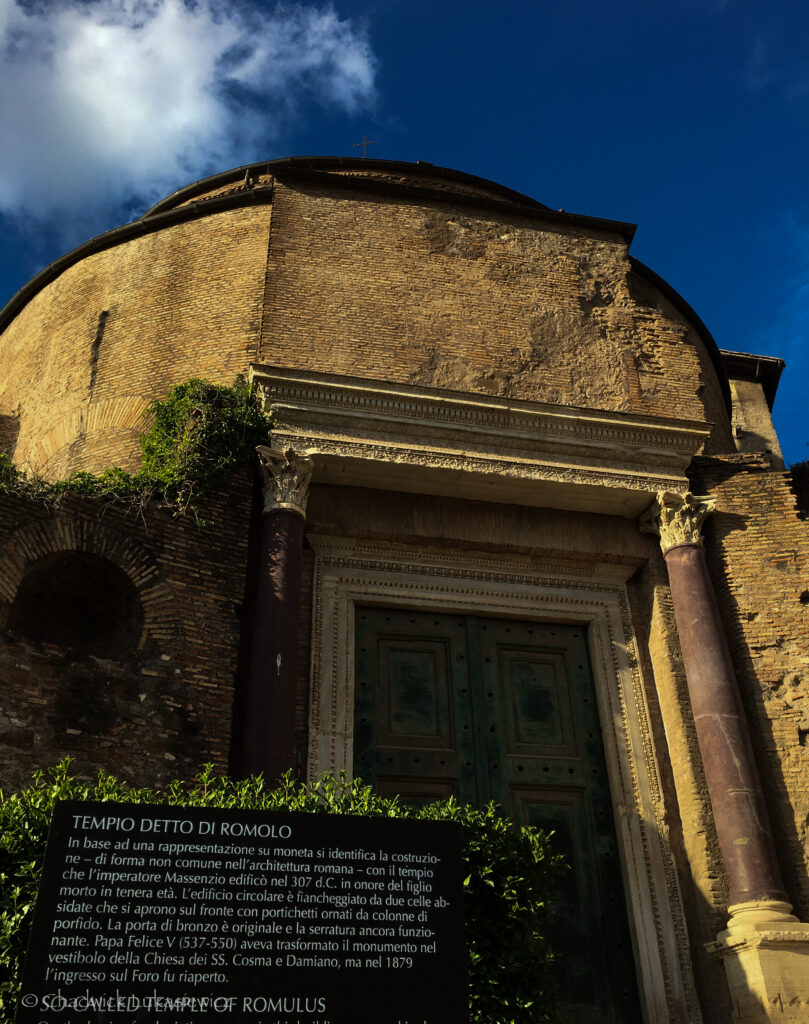

Remember, not every moment needs to be a perfect photo. Sometimes the best memories come from quick sketches, voice notes, or even collected ephemera. Here’s my multi-modal documentation approach:
Visual Documentation
- Quick architectural sketches or maps of the day
- Photo series of recurring patterns and iconic landmarks
- Time-lapse sequences of changing light
- Video panoramas for immersive memories
- All the best food, of course
Written Documentation
- Stream-of-consciousness observations
- Historical fact collections
- Sensory experience notes
- Questions to research later
Interactive Documentation
- Rubbing of interesting textures (where permitted)
- Collected tickets and maps
- Location-specific patches or postcards
- Small sketches of routes or architectural details
The ADHD-Friendly Travel Journal

My trusty Traveler’s Notebook has become my second brain during explorations. Here’s how I structure it for optimal ADHD use:
Daily Spreads
- Morning intentions and must-see sites
- Flexible schedule outline
- Space for random observations
- Quick sketch areas
- Quick map itineraries
Collection Pages
- Interesting historical facts
- Architecture/Cultural terminology
- Local phrases and translations
- Restaurant recommendations from locals
- Favorite foods and recipes
Sensory Records
- Weather conditions
- Light quality at different times
- Ambient sounds and local music
- Notable scents and textures
- Food experiences
Photography Tips for Ancient Sites
Here’s a few things I’ve learned about capturing these magnificent locations:
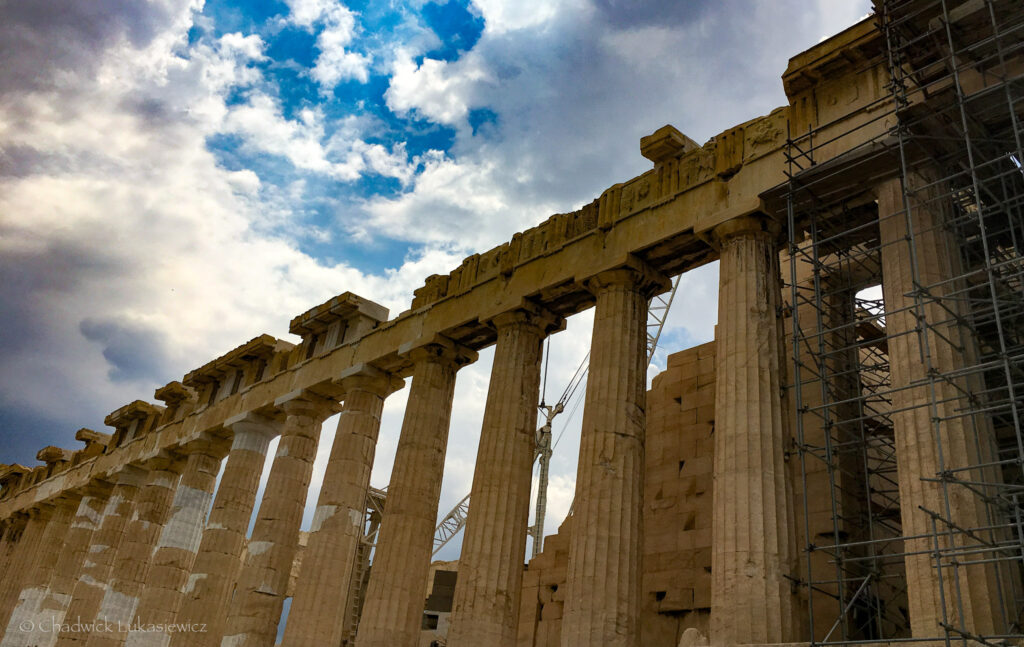
Best Times for Photos
- Golden Hour (first hour after sunrise and before sunset)
- Blue Hour (just before sunrise and after sunset)
- During brief rain showers
- Storm cloud cover
- Early morning before crowds arrive
Composition Ideas
- Use columns for natural framing
- Incorporate modern life for scale
- Focus on weathered details
- Capture reflections in puddles
- Look for symmetry in ancient architecture
Technical Considerations
- Bracket exposures for high contrast scenes
- Use polarizing filters for sky detail
- Consider HDR for interior/exterior transitions
- Pack a lightweight tripod for low-light situations

Remember to occasionally put the camera down and simply absorb the moment. Some experiences are best captured by our memories alone.
Fuel for Thought: ADHD-Friendly Dining in Athens and Rome

Let’s talk about one of my favorite parts of travel – food! But as an AuDHDer, I know that dining in new places can be both exciting and challenging.
Between sensory sensitivities, picky eating, and decision paralysis in the face of extensive menus and the need to maintain stable energy levels, mealtime requires its own special strategy.
Navigating Local Cuisine with Sensory Sensitivities
I’ll never forget that pivotal dinner in Athens that transformed my relationship with food. There I was, standing before a traditional taverna, the rich aromas of oregano and grilled meats mingling with animated Greek conversations and clinking glasses.
Instead of retreating to tourist comfort foods, I decided to kick the picky-eating habit and began developing what I now call the “Sensory Stepping Stone Method” – a way to honor both our neurodiverse needs and local food cultures.
The Sensory Stepping Stone Method:
- Start with Familiar Foundations
- Choose dishes featuring one familiar ingredient prepared traditionally
- Look for preparation methods you recognize (grilled, baked, fresh)
- Request authentic but simpler versions when needed
- Build confidence through small portions (meze or antipasti)
- Thoughtful Texture Progression
- Begin with local staples (fresh bread, pasta, rice)
- Notice how textures complement each other naturally
- Progress gradually to mixed-texture dishes
- Keep a “comfort dish” in mind as backup
- Temperature & Timing Strategy
- Learn optimal serving temperatures for local specialties
- Understand traditional meal timing
- Master basic temperature-related phrases
- Plan meals around your peak regulation times
- Connection Through Communication
- Learn 3-4 key food-related phrases
- Ask about family recipes and traditions
- Show genuine interest in preparation methods
- Express gratitude in the local language
Let me share my tried-and-tested progression for both cities.

Pro Tips for Cultural Navigation:
In Athens:
- Start with horiatiki (traditional Greek salad) – each ingredient distinct
- Try souvlaki for familiar proteins in local preparations
- Experience dolmades for gentle texture transitions
- Save strong flavors like feta for when you’re comfortable
In Rome:
- Begin with fresh pasta al pomodoro for familiar comfort
- Try suppli for controlled portion exploration
- Experience bruschetta for simple flavor combinations
- Progress to complex dishes like carbonara when ready
Cultural Awareness Notes:
- Express genuine interest in local food traditions
- Avoid comparing dishes to Western alternatives
- Appreciate the history behind preparation methods
- Thank servers and chefs in local language
- Be open to suggestions from local residents
Remember, our neurodivergent sensitivity to detail can actually enhance our appreciation of subtle flavors and ancient cooking methods. The goal doesn’t need to be “overcoming” our sensory preferences but to mindfully expand our comfort zone while honoring centuries-old culinary traditions.
Planning Meals for Optimal Energy and Focus

As any ADHD brain knows, proper fuel timing can make or break your day of exploration. Here’s one of my tried-and-true schedules:
Morning Routine
- Light breakfast at accommodation (protein-focused)
- or just a protein powder shake because I am often not hungry in the mornings. Find what works for you!
- Carry emergency snacks (nuts, dried fruit)
- Plan first coffee stop near morning site
Afternoon Strategy
- Late lunch (2-3 PM) to avoid crowds
- Choose restaurants away from tourist areas
- Include protein and complex carbs for sustained energy
Evening Approach
- Early dinner by local standards (7 PM)
- Quieter venues for sensory processing
- Light meals for better sleep
Must-Try Dishes That Engage the ADHD Brain
Let me share how our novelty-seeking ADHD minds can turn dining into an adventure through dishes that naturally engage multiple senses. These aren’t just meals – they’re multi-sensory experiences!
In Athens:

1. Saganaki
- The Experience: Flaming cheese presentation that’s pure ADHD dopamine
- Sensory Engagement: Watch the dramatic flame, hear the sizzle, smell the melting cheese
- Pro Tip: Order it as an appetizer when you need a focus reset
2. Moussaka
- The Experience: Layer-by-layer exploration of textures and flavors
- Sensory Engagement: Multiple textures from creamy béchamel to hearty meat
- ADHD Hack: Each layer provides a new taste adventure to maintain interest
3. Souvlaki
- The Experience: Interactive assembly and eating
- Sensory Engagement: Customize each bite, mix textures, hands-on eating
- Perfect For: When you need movement with your meal
4. Horiatiki (Traditional Greek Salad)
- The Experience: Build-your-own-bite potential
- Sensory Engagement: Bright colors, varied textures, fresh aromas
- Dopamine Boost: Create different combinations with each fork
5. Loukoumades
- The Experience: Watch them being made fresh, drizzled with honey
- Sensory Engagement: Crispy exterior, soft interior, sticky-sweet finish
- Timing Tip: Perfect for those late-night ADHD sugar cravings
In Rome:
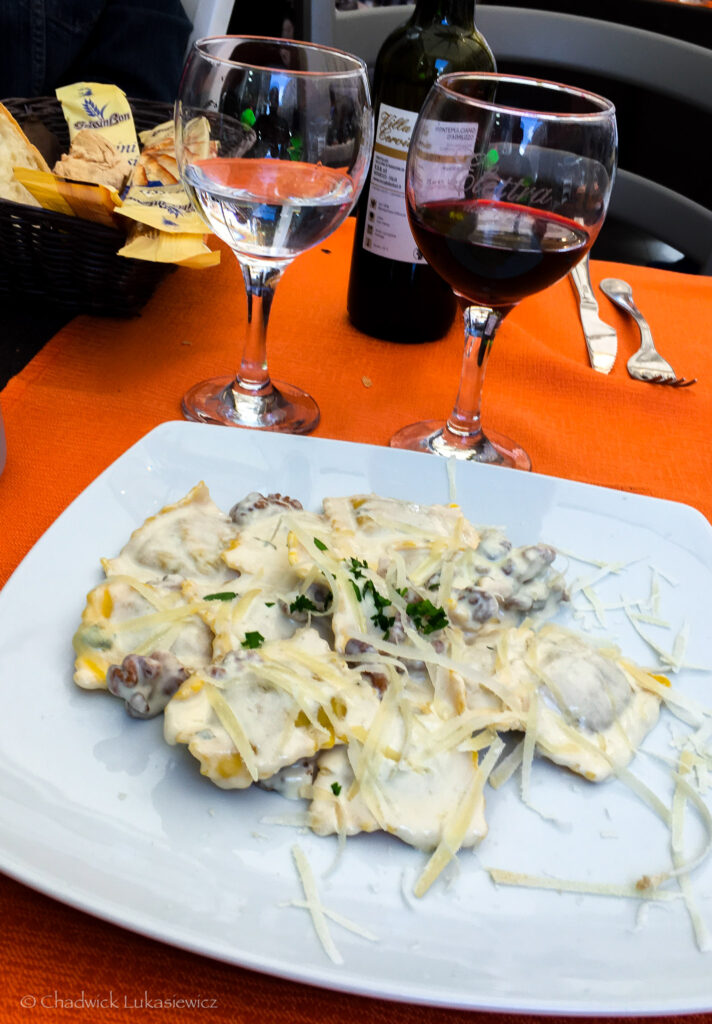
1. Cacio e Pepe
- The Experience: Watch the theatrical tableside preparation
- Sensory Engagement: The sound of pepper grinding, aroma of cheese, visual swirling
- Focus Factor: The preparation ritual helps transition into mealtime
2. Pizza al Taglio
- The Experience: Choose multiple varieties without commitment
- Sensory Engagement: Visual variety, different textures, mix-and-match
- ADHD Win: Reduces decision paralysis through sampling
3. Suppli
- The Experience: The perfect “cheese pull” moment
- Sensory Engagement: Crunchy exterior, gooey center, portable size
- Attention Span: Small bites perfect for restless moments
4. Carbonara
- The Experience: Rich, engaging textures that demand attention
- Sensory Engagement: Silky sauce, crunchy guanciale, pepper kick
- Pro Tip: Watch them toss it tableside for extra engagement
5. Gelato Artigianale
- The Experience: Multiple flavor sampling encouraged
- Sensory Engagement: Temperature contrasts, flavor combinations, color variety
- Decision Help: Start with one scoop, return for more – breaks choice overwhelm
Pro Tip: For both cities, I recommend finding restaurants with open kitchens whenever possible. Watching food preparation gives our ADHD brains something to focus on while waiting, turning potential restlessness into entertainment!
Recommended Restaurants for Neurodivergent Diners
Athens Favorites

1. Dionysos Zonar’s
- Location: Overlooking the Acropolis
- Ambiance: Spacious terrace with breathtaking views
- Best For: Sunset dining with natural sensory transitions
- ADHD-Friendly Features: Well-spaced tables, multiple exit routes
2. To Kafeneio
- Location: Plaka neighborhood
- Ambiance: Quiet courtyard setting
- Best For: Lunch breaks between exploring
- Specialty: Traditional Greek meze in sharable portions
3. Strofi
- Location: Near the Acropolis Museum
- Ambiance: Rooftop garden seating
- Best For: Evening unwinding
- Pro Tip: Request a corner table for optimal sensory management
Rome Must-Visits

1. Roscioli
- Location: Centro Storico
- Ambiance: Historic cellar with quiet corners
- Best For: Wine and pasta excellence
- ADHD-Friendly Features: Knowledgeable staff used to questions
2. Da Enzo al 29
- Location: Trastevere
- Ambiance: Charming outdoor seating
- Best For: Traditional Roman dishes
- Pro Tip: Go early to avoid crowds
3. Le Jardin de Russie
- Location: Near Piazza del Popolo
- Ambiance: Secret garden setting
- Best For: Special occasion dining
- Sensory Benefits: Natural sound barriers, plenty of space
Restaurant Selection Strategy

When choosing where to dine, consider these neurodivergent-friendly factors:
Environment Assessment
- Time of Day: Light sensitivity varies; choose accordingly
- Seating Options: Prefer corners or edges for better control
- Noise Levels: Ask about busy hours and music volume
- Temperature Control: Consider seasonal outdoor comfort
- Exit Routes: Always identify easy paths to step away
Menu Considerations
- Digital Access: Check website menus beforehand
- Modification Options: Confirm kitchen flexibility
- Portion Control: Look for half-portions or sharing options
- Safe Choices: Identify backup options for overwhelming days
Logistical Planning
- Location: Within 15-minute walk of accommodation
- Reservation Policies: Book ahead for peace of mind
- Payment Methods: Confirm card acceptance
- Accessibility: Note stairs, bathroom locations
Pro Tips for ADHD-Friendly Dining

- Timing Strategies
- Book for 7:00-7:30 PM to avoid peak crowds
- Allow 30-minute buffers for navigation
- Consider lunch as main meal for more options
- Use apps like TheFork for last-minute bookings
- Communication Prep
- Save key phrases in Notes app
- Screenshot menu items of interest
- Download offline translation features
- Save restaurant locations with landmarks
- Comfort Planning
- Pack sensory kit for dining
- Bring battery pack for devices
- Know nearby comfort spots
- Have backup dinner plans
- Social Scripts
- Learn basic ordering phrases
- Practice modification requests
- Keep dietary requirement cards or notes
- Master basic payment vocabulary/currency
Remember, you don’t have to let sensory sensitivities or ADHD challenges hold you back from culinary adventures – just approach them with strategy and self-compassion.
Nightlife and Downtime: Balancing Stimulation and Rest

How about the art of balancing evening adventures with our neurodivergent need for rest and recovery?
With my AuDHD, I’ve learned that nighttime in historical cities offers unique opportunities for both stimulation and sensory regulation – it’s all about finding the right mix.
ADHD-Friendly Evening Activities
Remember, our ADHD brains often come alive at night, so why not use that energy to experience these historic cities in a different light (literally)?
Unique Nightlife Experiences in Rome
1. Ice Club Roma – Sensory Adventure


Talk about sensory unique! During a trip with my mom and brother, stepping into this -5°C (23°F) wonderland was like entering another dimension.
Everything – from the walls to your drink glass – is carved from crystal-clear ice, and they provide thermal capes to keep you warm.
For our sensory-seeking ADHD brains, the controlled environment and unique sensory experience can actually be calming.
- Maintained at -5°C (23°F)
- Everything carved from crystal-clear ice
- Thermal capes provided
- Pro tip: Book ahead, limit visits to 30 minutes
2. Colosseum Night Tour – Thrilling History
Experience the Colosseum as the gladiators did – under the cover of darkness, when the ancient stones seem to whisper their secrets.
- Underground chambers by torchlight
- Smaller evening crowds
- Dramatic lighting effects
- Pro tip: Book “Underground After Hours” access
3. Monte Mario Stargazing – Peaceful Heights
Rome’s highest point offers a sanctuary of stars above the eternal city, perfect for our pattern-seeking minds.
- Rome Observatory visits
- Clear night sky views
- Telescope sessions available
- Pro tip: Check astronomy event schedules
4. Evening Vespa Tour – Adrenaline Rush
Channel your inner Roman Holiday while satisfying our ADHD need for speed and novelty through illuminated streets.
- Wind through illuminated streets
- Local guide navigation
- Photo stops at landmarks
- Pro tip: Choose private tours for flexibility
5. Trastevere Garden Bars – Sensory Calm
Hidden green oases provide the perfect balance of social energy and natural calm in Rome’s most charming neighborhood.
- Hidden courtyard settings
- Fairy light ambiance
- Natural sound barriers
- Pro tip: Arrive at aperitivo time (6-8 PM)
Unique Nightlife Experiences in Athens

1. Lycabettus Hill Sunset – Natural Wind-Down
Athens’ highest vantage point offers a natural dopamine boost as day transforms to night over ancient landscapes.
- Highest point in Athens
- Cable car option available
- Panoramic city views
- Pro tip: Arrive 30 minutes before sunset
2. Rooftop Bar Hopping – Thrilling Heights
Experience the Acropolis from every angle while our novelty-seeking brains enjoy constantly changing perspectives.
- 360° Acropolis views
- Multiple elevation changes
- Different music vibes
- Pro tip: Start at A for Athens
3. Night Climb to Philopappos – Adventure Rush
A moonlit hike that combines physical stimulation with historical awe, perfect for burning evening ADHD energy.
- Illuminated ancient paths
- Acropolis night views
- Less crowded experience
- Pro tip: Go with a guide first time
4. Open-Air Cinema Thision – Peaceful Evening
Watch modern films against an ancient backdrop – the perfect blend of familiar comfort and historic atmosphere.
- Movies under stars
- English films with subtitles
- Historic atmosphere
- Pro tip: Bring a light jacket
5. Plaka Music Tavernas – Controlled Energy
Traditional Greek music provides structured entertainment while the intimate settings help manage sensory input.
- Traditional live music
- Structured entertainment
- Indoor/outdoor options
- Pro tip: Reserve corner tables
Creating Your Evening Rhythm

I’ve found that alternating high-stimulation evenings with quieter nights helps maintain energy levels throughout the trip. Here’s my strategy:
High-Energy Evenings:
Pre-Activity Preparation
- Scheduled rest period (2-3 hours)
- Light dinner before going out
- Sensory kit packed
- Clear exit strategy planned
Activity Selection
- One main venue/activity
- Backup option if first choice overwhelming
- Time-boxed experience (2-3 hours max)
- Easy transport back to accommodation
Recovery Evenings:
In-Room Relaxation
- Simple room picnic
- Journal reflection time
- Photo organization
- Light stretching or yoga
Quiet Outdoor Options
- Evening walks in quieter neighborhoods
- Stargazing at ancient sites
- Hotel rooftop relaxation
- Small local café visit
Sleep Strategies in Ancient Cities

Let’s be real – our ADHD brains often struggle with sleep, especially in new environments. Here’s how to create a sleep-friendly space:
Room Selection Tips
- Request higher floors
- Ask for rooms away from elevators
- Check for blackout curtains
- Consider courtyard-facing options
Creating a Portable Sleep Environment
- Travel white noise machine or mindfulness app like Headspace or CaCalmlm
- Eye mask for varying light conditions
- Favorite sleep-inducing scent
- Familiar pajamas or comfort items
Evening Wind-Down Routine
- 30-minute buffer between activities and bed
- Cool or warm shower or bath (preference and season)
- Gentle stretching
- Mindfulness exercises like Headspace
Mindfulness and Grounding Techniques

When the ancient city’s energy gets overwhelming, try these neurodivergent-friendly grounding exercises:
The Roman Column Exercise
- Find a quiet spot near an ancient column
- Focus on its base touching the ground
- Mentally trace its height to the sky
- Connect your own feet to the same earth
Sensory Counting in Greek
- Learn numbers 1-5 in Greek
- Count them while touching different textures
- Match breath to each number
- Repeat until centered
Historical Connection Moments
- Touch a piece of ancient stone
- Imagine others doing the same through history
- Focus on the timeless nature of the moment
- Allow your racing thoughts to settle into perspective
Conclusion: Embracing Your Neurodivergent Journey Through Time

As we wrap up our exploration of Athens and Rome, I’m reminded of a quiet moment on the steps of the Parthenon. The morning sun was just beginning to warm the ancient marble, and my ADHD mind – usually racing with a thousand thoughts – found an unusual sense of peace.
In that moment, I realized that our neurodivergent traits aren’t obstacles to experiencing these historic wonders – they’re gifts that transform how we connect with the ancient world.
Essential Takeaways
- Preparation Empowers
- Research ignites our hyperfocus
- Strategic planning creates confidence
- Flexibility enables discovery
- Tools support success
- Mindful Exploration Matters
- Listen to your body’s signals
- Create intentional breaks
- Use your sensory kit
- Honor your limits
- Documentation Deepens Connection
- Photos preserve details
- Journals process experiences
- Collections tell stories
- Memories last lifetimes
Your Call to Adventure
Remember, every “quirk” of your ADHD (or AuDHD) becomes a strength in these ancient lands:
- Time blindness transforms into timeless exploration
- Pattern recognition reveals hidden histories
- Intensity of focus creates lasting memories
- Sensory awareness deepens cultural connections
Pack your sensory kit, charge your camera, and prepare to explore the streets where philosophers once debated and emperors once walked. Your neurodivergent mind isn’t just ready for this adventure – it’s uniquely designed to thrive in it.
Safe travels, fellow navigator! The ancient world awaits your unique perspective.
Some of the links in this post are affiliate links, meaning I earn a commission if you click through and make a purchase – at no additional cost to you. As a neurodivergent traveler and mental health professional, I only recommend products I’ve personally tested and found genuinely helpful in managing AuDHD symptoms, sensory needs, or travel challenges. Read our full affiliate disclosure in our privacy policy. And remember: your unique needs matter most when choosing tools for your journey!





